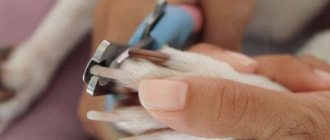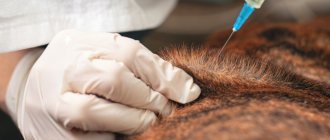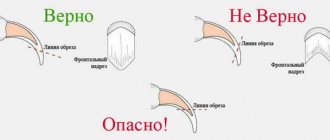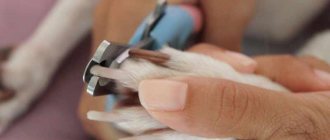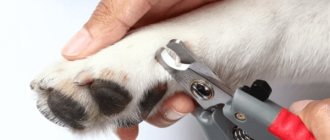Let's figure out how to give an injection to a dog yourself? How and where to give intramuscular injections correctly? How to give a subcutaneous injection to a dog? Are there any secrets to reducing stress in your pet during treatment?
Preparing the dog
First, the animal is calmed down by stroking and calm conversation. It is best to carry out the procedure after a walk and feeding, when the dog is in the most relaxed state.
Attention! The instructions for some drugs put forward conditions regarding the time of day or condition, food intake, so you should first carefully study the instructions and consult with your doctor.
Some dogs tolerate the procedure well, while others do not. Owners of restless animals need to ask their loved ones for help to hold their dog. This must be a person she knows. The assistant is located at the animal's head and strokes its chest and sides so as to prevent jerking. Rude behavior is unacceptable, as fear will make intramuscular injection difficult.
To prevent the dog from biting the owner and his assistant, it is recommended to use a muzzle. If there is no accessory, then the mouth is fixed with a bandage or other available means.
The muzzle will prevent injury to the owner and his assistant
Communication with your pet
If your dog resists in every possible way, then in such a situation it is strictly forbidden to resort to force. This behavior will further alienate the pet and it may subsequently become more aggressive. You should speak in a confident voice and be friendly at the same time. It is important not to neglect this recommendation, since animals are very sensitive to the internal panic of their owner. And if you are very nervous, you won’t be able to hide it.
If this is not the first time you have given an injection to your dog, then, first of all, you need to calm him down. Do not deceive your pet, it is better to immediately show him the syringe, then encourage him and ask him to behave well. Usually the four-legged animals agree to be patient, even if they know that the procedure is not entirely pleasant. The main thing is to be patient and talk to your dog gently.
If you are planning the first injection, then before injecting your dog into the withers, it would be a good idea to enlist someone else’s support. But not to hold your pet by force. An assistant will help distract him, pet him and talk to him while you carry out the procedure itself.
At the end, you need to praise and caress the animal. Treat him with some treat, and in the future your four-legged friend will know that for exemplary behavior a tasty treat awaits him.
Instructions
There are several varieties that differ in pain and in what drugs are administered with their help. It is ideal if the owner learns how to do them all.
We fix the pet before the injection
Few dogs, even flexible and kind ones, will take sudden pain well. And if she jerks too much - or, moreover, tries to run away - the needle will break off and you will have to go to the vet to get it out.
To prevent this from happening, you need to at least minimally prepare the dog:
- Choose the correct time if the instructions allow. Preferably after eating and walking, when the animal is relaxed and is not going to resist.
- Talk to the dog. Having placed it in the right place, give the command “sit”, and then, during preparation, speak in a calm, soft voice about anything. Before taking the injection, let the syringe smell and stroke it.
- Put on a muzzle. If there is a tendency towards aggression or cowardice, you need to wear a muzzle: this will prevent the owner from biting.
It is advisable that another person whom the dog trusts participate in the procedure. This person should come from the side of the head, sit on the floor and, holding the dog by the withers, distract him from the procedure. You can pet him, you can even offer him a treat.
If the dog handled everything calmly, didn’t try to run away, didn’t want to bite anyone, he is offered encouragement - a treat and affection. It is imperative that the idea “yes, they do something strange and even a little painful, but then they will give you something tasty” takes root in your head.
The association should be pleasant, otherwise the fixation will have to be carried out more harshly: roll it on its side and hold it by the withers and pelvis, with force. But then there is a great risk that each time the procedure will turn into a local war.
Intramuscular injections
When they say that you need to give an intramuscular injection to a dog, they usually mean that the injection should be in the thigh . The biggest muscle is there and everything will be the least painful.
The process is simple:
- Feel the thigh and find the place where the muscles are softest, usually located between the hip joint and the tibia. Since nerve ganglia are located in the thigh of canines, proceed with caution.
- Stretch the muscle with massaging movements. You can’t inject into a clamped one - the medicine will not be distributed correctly, and an allergy will begin.
- Insert the syringe sharply and easily - you can remember how nurses do this in clinics. You don’t need to go very deep, the main thing is to feel that the needle has entered the muscle. It is important to remember that she must walk at a right angle.
- Slowly and smoothly press the piston. Resistance should be felt, but the liquid must be injected slowly, otherwise it will not be able to distribute correctly and will form a drug-filled lacuna in the muscle.
- Gently, without excessive force, pull out the needle.
Preparing for the injection
To complete the medicine kit you will need:
- alcohol wipes or cotton wool soaked in alcohol;
- cotton ball;
- medicine, solvent for it;
- syringe, preferably with two needles.
Types of syringes
For dogs weighing up to 5 kg, insulin syringes are used if there is no need to inject viscous oily solutions that such a needle cannot pass through, or the dosage of the medicine does not exceed 1 ml. In other cases, preference is given to an instrument with a capacity of 2–3 ml. For representatives of large breeds, syringes of 5–10 ml are used, but they try to use a thinner needle (as much as the drug allows).
Before the injection, wash your hands thoroughly and treat them with an antiseptic, for example, chlorhexidine. Do not touch the needle.
Antiseptics for hand treatment
Carefully study the instructions for the drug and prepare solvents. Cold liquids are heated by immersing the bottle in warm water (about 40 ° C) or left for some time at room temperature. This will reduce pain in the animal and prevent complications. They also study the date of manufacture of the drug to ensure its suitability, check the integrity of the packaging and compliance with the concentration prescribed by the veterinarian.
Before use, carefully study the instructions for the drug
Attention! Ready-to-use solutions should not contain sediment, and the color should correspond to that described in the instructions. Otherwise, use of the drug is prohibited.
Next, check the syringe. Cracks in the body or damage to the needle are unacceptable. If an expiration date is indicated, then after its expiration the product is not used. The type and capacity of the syringe should correspond to the medicine and its dosage, but be slightly larger.
If necessary, mix the drug by rolling the bottle between the palms of your hands. There is no need to shake the container to prevent air from getting into the liquid.
Then proceed in this order:
- Remove the metal cap from the bottle.
- Wipe the lid with an alcohol wipe.
- Use a needle to pierce the lid or cut off the glass top with a blade.
- Connect the syringe.
- Take the required dose.
Many medications come in powder form and must be diluted before use. Then first draw the solvent into the syringe, then inject it into the ampoule with the powder and stir until the product is completely dissolved.
All air must be removed from the syringe
Next, you need to check whether air has gotten inside. To do this, lightly tap the syringe with your fingernail. If air was in the liquid, it rises to the surface. Then press down on the plunger until several continuous drops of liquid emerge from the needle.
Video - How to dilute drugs
Syringe kit rules
To understand how to correctly draw a syringe, consider a small algorithm:
- wash your hands thoroughly;
- wipe the ampoule with an alcohol-containing solution (before doing this, you need to read the name of the drug and the dosage on the ampoule so as not to introduce another medicine by mistake, also read the instructions carefully - you may need to shake it);
- file the thinnest part of the ampoule (some preparations have a ready-made sawed “neck”) and break it;
- take a new syringe and, without touching the needle with your hands, draw up the drug sterilely;
- expel the air from the syringe with a piston;
- Collect the remaining bubbles by lightly tapping under the base of the needle and squeeze out with a gentle movement of the piston.
IMPORTANT!
- do not use drugs from open ampoules;
- do not use previously opened syringes and needles;
- Under no circumstances should you put the drug into a syringe in front of an animal - this may affect the emotional state, which will lead to problems with the manipulation.
To save money, you can draw several doses of the drug into a syringe, inject one dose, and store it in the refrigerator. Warm it in your hand before use.
Subcutaneous administration of medication
A subcutaneous injection is most often given at the withers. This is the area on a dog's body where the shoulder blades of the front legs meet. The location has many advantages: it is impossible to hit large blood vessels and nerves here. This minimizes the likelihood of injury to the animal. In general, subcutaneous administration of small doses is possible on any area of the skin where the skin can be pulled back. The disadvantage of this method is that the active substances are absorbed for a relatively long time during this administration and slowly enter the bloodstream. Therefore, in emergency cases, subcutaneous injections are not very effective.
This is interesting! To divert attention from the pain, during the subcutaneous injection, the person helping to hold the dog should grasp the fold of the dog's armpit with two fingers.
The injection site is first disinfected. The skin on the withers is gathered into a “house” and a needle is inserted in the direction of the spine, closer to the base of the formed fold, at an angle of 90° to it. When done correctly, the needle seems to fall through, and the liquid flows freely from the syringe.
Proper skin grip
Attention! For all injections, the syringe is pulled out at the same angle at which it was injected. Sterile cotton wool is applied to the puncture site on the skin and pressed lightly.
Video - Hypodermic injection for a dog
Execution technique
After preparation, you need to move on to action and do the following:
- Take the medicine after opening the ampoule. If the cat is not given an injection at the same time, then it is better to cap the needle to prevent infection.
- Take the skin in the withers area with your fingers and pull it up a little. There are no nerve endings in this place, so penetration of a needle into this layer will not cause discomfort. All this time you should calm your pet.
- After this, you need to move on to a procedure that will help you understand how to inject a cat at the withers. You will need to spread the wool, remove the cap and insert the needle at an angle. Press the plunger while injecting the medicine slowly.
- Look through the fur, if it is not wet, then the drug enters intramuscularly under the skin.
- Carefully pull out the needle and straighten the fur. There is no need to disinfect the wound.
- There is no need to release the pet yet. You should calm him down, hold him in your arms, and massage the place of the cat’s withers where the injection was given.
- After the procedure, the instruments and the remains of the ampoule should be put in a container, write on it that it contains piercing and sharp objects, in order to simplify the work of people who will throw out the garbage.
Before giving an injection to the withers, you need to carefully check the expiration date of the medicine and examine the skin on which the effect will be carried out. If there are wounds or inflammations, it is better to postpone this procedure or consult a veterinarian about its implementation.
Intramuscular injection in dogs
When there is a choice between intramuscular and subcutaneous administration, it is better for a beginner to choose subcutaneous, especially when there is no experience at all in carrying out this type of procedure. Very often, intramuscular injections result in lameness, especially when it comes to representatives of small breeds. In addition, there is a possibility of an abscess. If the hind limb is injured, then the injection is given in the shoulder of the front limb.
Places on the body for intramuscular injection
The injection site is disinfected with medical alcohol. The syringe is positioned at an angle of 90°. With a sharp movement, the tip of the needle is pierced into the muscle to a depth of about 5 mm and the drug is carefully poured in, putting pressure on the piston. The muscle will not change position if the unoccupied hand is placed under the thigh. Painful injections are administered slowly, at the same speed.
After the injection, the pet is rewarded with a favorite treat, and if this is prohibited by the conditions of therapy, then with gentle words and stroking.
Attention! A single dose of the drug administered in this way should not exceed 5 ml, even for representatives of large breeds. If a large dose needs to be administered, it is divided into two parts and injected into different muscles.
Video - Intramuscular administration of the drug
Installation of a dropper
Veterinarians can tell you how to put an IV on a puppy or dog, but they do not recommend doing this procedure at home. When administered by drip, the drug should enter the vein slowly. During this time, the pet must be fixed in a motionless position or put into medical sleep.
If the animal is prescribed a long course of intravenous injections or drips, a catheter can be installed. This is the name of a device consisting of a needle and a short tube for connection to other medical devices. A dog can only be catheterized in a clinic setting.
Where to inject - choose and prepare the place
“Giving” an intramuscular injection is not easy, especially when the owner has no experience in carrying out this procedure. Everyone is scared for the first time - what if I inject in the wrong place, what if I puncture a nerve, what if I damage a bone or vessel with a needle. Psychologically, it is also very difficult to stick a syringe into a pet’s paw. Here it is important to understand that you are not torturing the animal, but on the contrary, you are prolonging its life and taking care of its health. Following our instructions, you can inject your dog. So:
Injections are given intramuscularly in the hind leg. Carefully examine your pet's paw from the side, assessing the volume of muscles, thickness of bones and skin. The picture below clearly shows the area that should be carefully palpated.
The blue dot is the right place
The burgundy lines are the pelvic bone, femur bone, tibia (small and large). The dog needs to give an intramuscular injection into the thigh muscle, approximately where we see the blue dot in the picture.
Important! The safest area is from the femur on the right, if you look at the left paw, if at the right, then vice versa. It is in this part that there are no large blood vessels, tendons, or nerve endings; the bone is located far from the site of needle insertion. Therefore, even without experience, there is no chance of harming anything to the dog.
The needle should be inserted into the most powerful part of the muscle; it can be easily felt - you will always feel how the muscles roll during palpation. Above/below the muscle is thinner, it is taut and hard. It is extremely undesirable to stab into these places - it will hurt the animal, and you can damage a nerve, bone, or joint.
During the procedure, the muscle must be relaxed. You can relieve tension if you lightly massage the injection site when the paw is in a bent position. Before inserting a needle, it is not necessary to treat the injection site with alcohol - the dog’s skin is distinguished by the presence of a reliable antibacterial layer.
Intravenous injection through a catheter
This method is considered the most effective in intensive care, and this is the main advantage. However, without a catheter installed in the dog’s body, it is quite difficult to do this yourself, without special skills.
If the dog is undergoing treatment and a catheter is installed in the paw for administration, the task is simplified. Before injecting the medicine, make sure that the device has not moved and is in the blood vessel. This is tested by injecting a small dose of sodium chloride solution. If the piston moves tightly, and a swelling forms near the place where the device is installed, then the drug cannot be injected. You need to replace the catheter first.
It is convenient to infuse medications through a catheter
The cap is removed from the catheter and a syringe with saline solution is attached to it. To flush, pour 2–3 ml of solution into the hole, and another 2–3 drops into the port. Then connect a syringe filled with medication and slowly inject the drug.
Attention! Medicines are administered very slowly. A high rate of drug administration may subsequently cause vomiting in the animal.
After each injection, the device is washed with saline solution.
Video - How to administer drugs intravenously to animals through a catheter
Heat
A slight increase in the animal’s body temperature after injection is considered an adequate reaction of the body.
- But if the high temperature persists for more than 3 days, then you need to immediately go to the veterinary clinic.
- Typically, this complication is associated with an allergy to a drug or the development of an inflammatory process.
We hope that this material was useful to you, and now you can give your cat an injection yourself. Good luck!
Injection errors
One of the most common mistakes is a poorly secured needle . The needle “shoots” when the plunger of the syringe is pressed. This happens especially often if viscous liquids are administered - for example, oil vitamins, antibacterial drugs, etc.
People who have not injected before may insert the needle too deeply and pierce the skin fold all the way through. To prevent this from happening, the injection is made not at the top of the resulting triangle, but almost at its very base.
Correct and incorrect direction of injection
Another mistake is using a blunt instrument . Very often, one needle is used to pierce the cap of a bottle of medicine and for subsequent administration of the drug. This is not necessary because the animal will experience more pain than usual. To ensure that the injection brings minimal discomfort, two needles should be used. Veterinarians also do not recommend mixing two drugs in one syringe.
Attention! Not all medications are compatible. Injecting different medications from the same syringe can lead to an allergic reaction in a dog.
Video - How to dissolve powder preparations
Methods of drug administration
Before injecting a drug, you need to find out which method of administration is provided for a particular drug.
Table 1. How some drugs are administered.
| Type or name of medicine | Route of administration |
| Oil solutions | Intramuscular, subcutaneous |
| Irritants | Administered intravenously only (must be specified in the instructions) |
| Vitamins | It is not recommended to administer intramuscularly as they cause pain |
| Suspensions | Not administered subcutaneously due to the risk of infiltration |
Attention! Care must be taken when administering oil solutions intramuscularly to avoid getting into a blood vessel. A drop of such a drug in the bloodstream causes an oil embolism and the death of the animal.
Therefore, before infusing the medicine, check whether the needle has entered a blood vessel. After puncturing the tissue, the piston is pulled slightly towards itself. If blood appears in the syringe, choose another injection site.
Required documents confirming vaccination
The ability to quickly and correctly give an injection will not only save money, time and nerves, but in some situations it will help save the dog’s life. This is especially true in acute conditions - poisoning, severe pain due to injuries, and the like. For example, quickly administered Pyridoxine during symptoms of Isoniazid poisoning gives the dog a great chance of survival. You can read more about this in the article “How dog hunters poison dogs. How to act in case of poisoning." Intramuscular injections are prescribed for almost all diseases. After all, the same active substance, introduced into the body in the form of an injection solution, “works” much faster than tablets, since it enters directly into the blood. This feature is important for diseases accompanied by vomiting - when no medications simply can be absorbed from the stomach. By carefully following all the specialist’s recommendations, you will quickly master the technique of performing intramuscular injections - whenever necessary, you will be able to help your dog. When carrying out this difficult manipulation, it is important to choose the right injection site, select/prepare the syringe correctly, and perform the procedure technically. Let's talk about everything in more detail.
Why do you need such skills?
The ability to give an injection may be required when:
- the medicine must be administered immediately;
- there is no opportunity to show the animal to a veterinarian in the near future;
- the dog is very nervous when visiting the “doctor”;
- a long course of treatment is required (you can save money by visiting the clinic).
Important! You need to understand that there are drugs that can only be administered by injection by a veterinarian. This primarily applies to vaccines (including against rabies). Self-administered vaccinations are not recognized by any health service. Vaccination must be performed in a certified clinic; the procedure must be certified by a veterinarian’s signature and seal.
Complications
Failure to comply with the rules for carrying out such manipulations is fraught with complications. Moreover, they happen even to people with experience.
Lameness
The dog may experience lameness. Typically, the complication manifests itself after painful injections, during which the animal even whines or breaks out. A nerve may also be affected.
If lameness does not go away for a long time, you should consult a doctor
To improve the condition, the injection site is gently massaged several times a day with rubbing movements clockwise and in the opposite direction. If a lump pops up at the injection site or the condition has not returned to normal after two days, the help of a doctor is needed.
Formation of infiltrate
In the tissues where the injection was administered, an infiltrate sometimes forms, that is, cellular elements mixed with blood and lymph, and sometimes pus, accumulate in this area.
Errors that cause this phenomenon:
- infusion of the drug into the same place on the animal’s body;
- ignoring the norms of asepsis and antisepsis;
- improper removal of the needle when working with irritating compounds;
- infusion of an irritating drug under the skin or into connective tissue;
- the use of cold preparations, especially suspensions, as well as oily solutions, biological drugs.
To avoid such a complication, it is necessary to constantly change the location of the infusions, and not to inject irritating agents under the skin. Before use, the compositions are heated, especially oil ones, to avoid vasospasm and speed up the resorption of the solution. The infiltrate is resolved by iodine mesh or heat.
An iodine grid will help
Attention! You should not heat the damaged area if the swelling becomes larger and itches. This is a reason to contact a veterinarian.
Abscess
With this complication, a cavity forms in the skin where pus accumulates. The development of phlegmon, a purulent-diffuse inflammation, is also likely.
Subcutaneous abscess in a dog
With purulent inflammation, the temperature locally rises, the size of the swelling increases, and at the first stage it thickens. At the end of its formation, the formation softens in the center or in several places. When touching the abscess, the dog feels pain. The pet may develop a fever and refuse to feed. All sorts of digestive upsets and dehydration can occur.
Different syringes are used for different medications
The main reasons for the complication are the same - violation of aseptic and antiseptic standards, as well as infusion of medicine into loose tissue. To prevent an abscess, you should:
- use a new syringe for each product;
- use medications from ampoules that are opened immediately before use;
- treat the injection site with alcohol for intravenous, intraarterial, intraosseous administration.
At the initial stage, the abscess is treated with short novocaine blockades, and other options of physiotherapy are resorted to. In the final stages, surgical methods are used to clean the abscess cavity from pus.
Reference. A short novocaine blockade is an anesthesia in which the medicine is administered around the inflamed area.
Tissue necrosis
This is a process in which destruction and death of tissue occurs, accompanied by the formation of blisters and ulcerations. The dog feels pain at the injection site, swelling and bluish skin develops.
Necrosis often occurs after improper administration of irritating substances. To prevent this, the patency of the catheters through which drugs are administered should be checked.
If, during intravenous administration, the drug spills under the skin, then they try to draw out the solution with a syringe, and inject the affected area with novocaine. An effective measure is applying a cold compress.
Applying ice is an effective method
Allergic reaction
Usually occurs in response to the administration of a low-quality, expired drug or hypersensitivity to this drug in an animal. To prevent this, a sensitivity test is performed before administration. If symptoms of a sharp allergic reaction occur - for example, convulsions, respiratory problems, then the administration of the drug is stopped and antihistamines are used.
Allergy in a dog
You can read more about allergies in dogs on our website.
How to properly prepare an injection
The next step is to prepare the syringe.
- The owner thoroughly disinfects his hands with soap.
- Pick up the ampoule and carefully read the instructions again. Compare what is written with the doctor’s dosage.
- Wipe the ampoule and hands with an alcohol-containing solution.
- Cut the packaging and open it. Do not leave glass near your dog; he can easily put it in his mouth and chew it.
- Open the package with Spitz and take the required amount of solution.
- Turn the syringe over with the needle facing up and tap it. Make sure the liquid is evenly distributed inside.
- Start moving the dispenser slowly so that the air comes out.
Read 10 symptoms of allergies in dogs and effective ways to treat the disease
Important! Experts who make injections for dogs recommend using the liquid drawn up into a syringe within 5 minutes. Otherwise, the solution will gradually begin to lose its beneficial properties.
General Tips
If we remove the specifics and give a few general tips that can help carry out all these procedures faster, more pleasantly and efficiently, then the main thing here, of course, will be simply to show love for the dog. This lies in the maximum responsibility and affection that the dog feels.
To make it easier, you can read not only the text tips and instructions, but also watch several videos on how to give injections to dogs.

